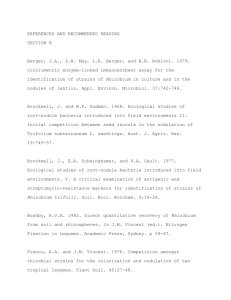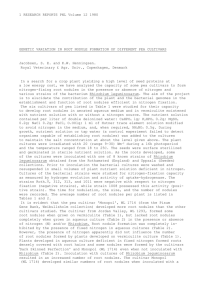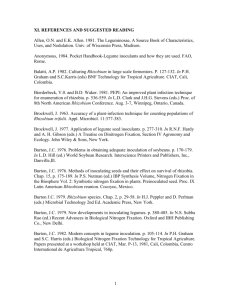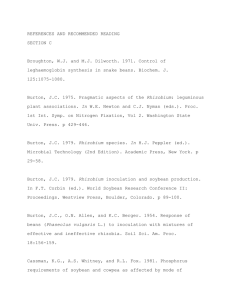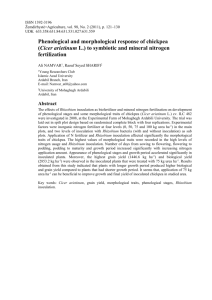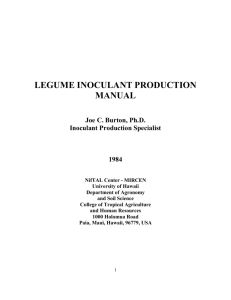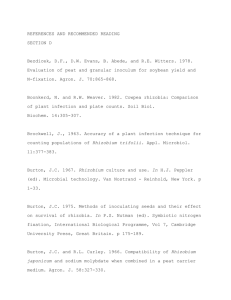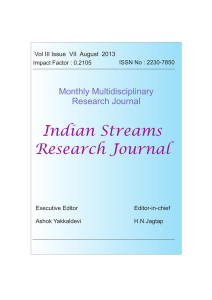Article - I
advertisement
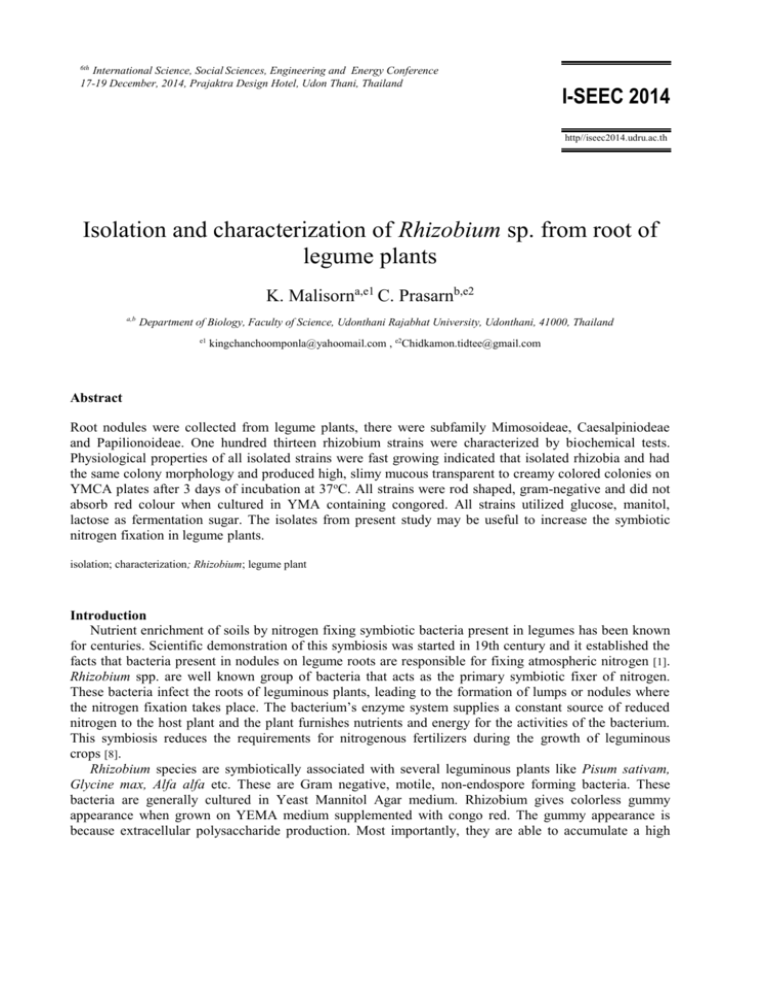
6th International Science, Social Sciences, Engineering and Energy Conference 17-19 December, 2014, Prajaktra Design Hotel, Udon Thani, Thailand I-SEEC 2014 http//iseec2014.udru.ac.th Isolation and characterization of Rhizobium sp. from root of legume plants K. Malisorna,e1 C. Prasarnb,e2 a,b Department of Biology, Faculty of Science, Udonthani Rajabhat University, Udonthani, 41000, Thailand e1 kingchanchoomponla@yahoomail.com , e2Chidkamon.tidtee@gmail.com Abstract Root nodules were collected from legume plants, there were subfamily Mimosoideae, Caesalpiniodeae and Papilionoideae. One hundred thirteen rhizobium strains were characterized by biochemical tests. Physiological properties of all isolated strains were fast growing indicated that isolated rhizobia and had the same colony morphology and produced high, slimy mucous transparent to creamy colored colonies on YMCA plates after 3 days of incubation at 37oC. All strains were rod shaped, gram-negative and did not absorb red colour when cultured in YMA containing congored. All strains utilized glucose, manitol, lactose as fermentation sugar. The isolates from present study may be useful to increase the symbiotic nitrogen fixation in legume plants. isolation; characterization; Rhizobium; legume plant Introduction Nutrient enrichment of soils by nitrogen fixing symbiotic bacteria present in legumes has been known for centuries. Scientific demonstration of this symbiosis was started in 19th century and it established the facts that bacteria present in nodules on legume roots are responsible for fixing atmospheric nitrogen [1]. Rhizobium spp. are well known group of bacteria that acts as the primary symbiotic fixer of nitrogen. These bacteria infect the roots of leguminous plants, leading to the formation of lumps or nodules where the nitrogen fixation takes place. The bacterium’s enzyme system supplies a constant source of reduced nitrogen to the host plant and the plant furnishes nutrients and energy for the activities of the bacterium. This symbiosis reduces the requirements for nitrogenous fertilizers during the growth of leguminous crops [8]. Rhizobium species are symbiotically associated with several leguminous plants like Pisum sativam, Glycine max, Alfa alfa etc. These are Gram negative, motile, non-endospore forming bacteria. These bacteria are generally cultured in Yeast Mannitol Agar medium. Rhizobium gives colorless gummy appearance when grown on YEMA medium supplemented with congo red. The gummy appearance is because extracellular polysaccharide production. Most importantly, they are able to accumulate a high 2 amount of PHB intracellularly [4]. Rhizobiaceae family contains six genera namely Rhizobium, Sinorhizobium, Mesorhizobium, Allorhizobium, Azorhizobium and Bradyrhizobium [5]. Biofertilizer promotes plant growth and productivity has internationally been accepted as an alternative source of chemical fertilizer. Rhizobacteria effectively colonize plant root and increases plant growth by production of various plant growth hormones, P-solubilizing activity, N2 fixation and biological control activity [1]. A well established practice for maintaining soil fertility has been the cultivation of leguminous plants which replenish atmospheric nitrogen through symbiosis with rhizobia in rotation with non leguminous plants [7]. In the present study, Rhizobium spp. were isolated from root nodules. Further characterization was done by performing various biochemical test. Materials and Methods Rhizobium Isolation from root nodules of legume plant The fresh and plump root nodules of legume plant were collected from different location in UdonThani province, Thailand. The collected nodules were surface-sterilized with 95% ethanol and 3% H2O2 and washed thoroughly with distilled water. Rhizobium strain was obtained by streaking the crushed root nodules on YMCA (10g/L manitol, 0.5g/L K2HPO4, 0.2g/L MgSO4.7H2O, 0.1g/L NaCl, 4g/L CaCO3,0.4g/L Yeast extract, 0.25% congo red, 15g/L agar, pH 7.0) agar plates and incubated at 37°C. After 5 days of incubation, Rhizobium colonies were obtained. Rhizobium colonies were remained white, translucent, elevated and mucilaginous, where as contaminations turned red. The colony were piked up and transferred to YMA slant for further characterization. Microbiological assays The morphological traits evaluated comprised colony morphology, mucous production and change in pH of medium YMBA (10g/L manitol, 0.5g/L K2HPO4, 0.2g/L MgSO4.7H2O, 0.1g/L NaCl, 4g/L CaCO3,0.4g/L Yeast extract, 0.5% bromthymol blue, 15g/L agar, pH 7.0) during growth and growth rate. Mucous morphology analysis was based on type, elasticity and appearance, while colony morphology parameters were diameter, form, transparency and color. Gram staining reaction was performed to evaluate type of strain and cell shape [3]. Sudan black B staining PHB producing bacteria was further confirmed using Sudan black B staining method [6] with some minor modifications. Sudan black B stain was prepared as0.3% solution (w/v) in 60% ethanol. The smear of cultures was prepared on glass slides and heat fixed. The samples were stained for 10 min with Sudan black solution, rinsed with water and counter stained with 0.5% safranin for 5min. and observed at 1000X magnification. Glucose peptone agar (GPA) and lactose assay GPA assay was performed to determine the capability of the microorganism to utilize glucose as the sole carbon source for its growth. GPA medium (5g/L glucose, 10g/L peptone, 15g/L agar, pH 7.0) was inoculated with Rhizobium culture, incubated and growth was observed. Similarly lactose assay was performed to determine the capability of Rhizobium spp. to utilize lactose present in YLA (10g/L lactose, 0.5g/L K2HPO4, 0.2g/L MgSO4.7H2O, 0.1g/L NaCl, 4g/L CaCO3,0.4g/L Yeast extract, 15g/L agar, pH 7.0) as the sole carbon source for its growth. Litmus milk test Litmus milk is a complex medium that can potentially distinguish among many species of bacteria. Litmus milk has several components that can be metabolized: lactose (milk sugar); casein (milk protein); and litmus (a pH indicator that is purple to blue at neutral to alkaline pH and pink under acidic conditions). Litmus milk broth (100g/L Skim milk powder, 0.075g/L Litmus, pH 6.8) was inoculated with Rhizobium culture, incubated and growth was observed. Results and Discussion Sesbania javanica, Mimosa pigra, M. pudica, Leucaena leucocephala, Tamarindus indica, Butea monosperma, Doliches lablab, Dalbergia duoerreana, Vigna unguiculata, Pterocarpus indicus, Sesbania Author name / Procedia Engineering 00 (2011) 000–000 grundiflora and Arachis hypogaea, there were collected for legume plants sample to isolated Rhizobium strains (Fig. 1). A loopful of crushed root nodule were streaked on YMCA plates and incubated at 37°C for 5 days. Isolates of Rhizobium in 113 isolates that produced colorless gummy colonies on media plates (Table 1)., they were found to be fast-growing and moderate to slow-growing. For acid production in YMBA found some strains positive and some strains negative. All the isolates were stained with Gram’s reagents for detection of their Gram reaction. Pink colored rod shaped cells were observed under microscope. All the isolates found to be Gram negative (Fig. 2) and rod shape. To distinguish PHB producer, they were stained with sudan black B dye. Dark black to purple granules were observed intracellularly with pink background when counterstained with safranin. This confirmed that all isolates were capable to accumulate PHB intracellularly. All Rhizobium isolates were able to grow on GPA medium showing the utilization of glucose as the carbon source. However, some pure Rhizobium isolates are unable to grow on lactose. Casein utilization and peptonization were resulted in litmus milk test by Rhizobium isolates. Most of the biochemical tests were giving same results as reported for Rhizobium spp. in literature. Table 1. Colony characterization and number of Rhizobium strains isolated from various of legume plants Legume plants species Colony color on YMCA Colony texture on YMCA Number of isolates Sesbania javanica white gummy 4 Mimosa pigra white gummy 14 M. pudica white gummy 5 Leucaena leucocephala white gummy 15 Tamarindus indica white gummy 4 Butea monosperma white gummy 7 Doliches lablab pink gummy 7 Dalbergia duoerreana pink gummy 12 Vigna unguiculata pink gummy 2 Pterocarpus indicus, white gummy 13 Sesbania grundiflora white gummy 22 Arachis hypogaea pink gummy 8 Fig.1 Root of Mimosa pigra showing nodules developed by symbiotic bacterium R hizobium Fig.2 Gram negative rod shaped Rhizobium cell showed at 1000X magnification Acknowledgenment Authors are thankful to Udonthani Rajabhat University for providing facilities research work. References [1] Deshwal VK, Vig K, Amisha DM, Yadav P, Bhattacharya D, Verma M. Synergistic effects of the inoculation with plant growth-promoting Rhizobium and Pseudomonas on the performance of Mucuna. Ann. Forestry. 2011; 19(1): 13-20. [2] Dilworth MJ, Parker CA Devolopment of the nitrogen fixing system in legumes. J. Theor. Biol. 1969; 25: 208-218. 3 4 [3]Holt J.G., Krieg N.R., Sneath P.H.A., Staley J.T. and Williams. S.T. Bergey’s manual of Systematic Bacteriology. 9th ed. Williams & Wilkins: USA. 1994. [4] Kumari P, Dhingra KH. Isolation and characterization of PHB producing micro-organisms isolated from root nodules of leguminous plants. An international quarterly journal of life science. 2013; 8(1): 109-113. [5] Okazaki S, Nukui N, Sugawara M, Minamisawa K. Rhizobial strategies to enhance symbiotic. Interactions: Rhizobiotoxine and 1-Aminocyclopropane-1-Carboxylate deaminase. Microb. Environ. 2004; 19(2): 99-111. [6] Schlegel, H. G., Lafferty, R. and Krauss, I. The isolation of mutants not accumulating poly-betahydroxybutyric acid. Arch. Microbial. 1970; 70: 283-294. [7] Shahzad F, Shafee M, Abbas F, Babar S, Tariq MM, Ahmad Z. Isolation and biochemical characterization of Rhizzobium meliloti from root nodules of Alfalfa (Medico sativa). The Journal of Animal & Plant Science. 2012; 22(2): 522-524. [8] Zsbrau HH. Rhizobium-Legume symbiosis and nitrogen fixation under sever conditions and in arid climate. Microbiol. Mol. Biol. Rev. 1999; 63: 968-989.

